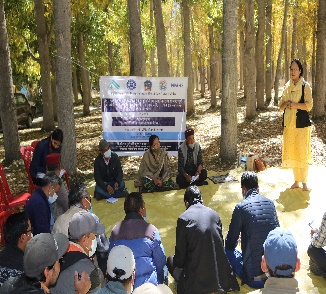Ex-situ conservation and development of gene bank of commercially important threatened medicinal plants in the high-altitude areas, Himachal Pradesh
The Himalayan region, a global repository of unique biodiversity, has been facing unprecedented pressure due to large-scale overexploitation, unregulated harvesting, and habitat destruction of commercially important medicinal plant species, leading to considerable reductions in their populations and causing many species to be listed in the Red Data Book of threatened flora. Recognizing the ecological, medicinal, and socio-economic importance of these species, urgent interventions were required to conserve and sustainably utilize them before they vanished from their natural habitats. In this context, the present study focused on the ex-situ conservation and establishment of a gene bank for three rare, endangered, and threatened (RET) species; Angelica glauca, Carum carvi, and Arnebia euchroma, all of which are valued for their medicinal and aromatic properties, but whose natural populations have dwindled due to unsustainable extraction, habitat fragmentation and climatic change. The objective of the initiative was not only to conserve these RET species outside their natural habitat but also to generate quality planting material (QPM) for future cultivation and sustainable resource utilization, thereby reducing pressure on wild populations while simultaneously promoting livelihood opportunities for mountain communities. For this purpose, a total of 12 accessions representing the three target species, seven of Angelica glauca, two of Carum carvi, and three of Arnebia euchroma were collected from different ecological zones of Himachal Pradesh to capture genetic diversity, and subsequently sent to the Institute of Himalayan Bioresource Technology (IHBT) at Ribling and Palampur for multiplication through advanced tissue culture techniques and chemical profiling, ensuring not only the availability of large-scale planting material but also the maintenance of phytochemical integrity required for medicinal use.
The programme achieved a breakthrough in the successful cultivation of Carum carvi in high-altitude areas such as the Tirthan Valley of Kullu district and parts of Lahaul and Spiti, where the agro-climatic conditions proved highly favourable for its growth; this resulted in the production of around 20,000 plants, marking a significant milestone in bringing a RET species under organized cultivation. Alongside cultivation efforts, the initiative also prioritized capacity building and knowledge dissemination among local farming communities, recognizing that community involvement is indispensable for the long-term success of conservation programmes. Four intensive awareness-cum-training programmes were organized in Kullu and Lahaul & Spiti districts, reaching out to and building the capacity of 132 farmers, equipping them with skills in scientific cultivation, sustainable harvesting, and post-harvest management of medicinal plants. These programmes not only created awareness regarding the ecological importance of RET species but also demonstrated how their cultivation could open up niche livelihood avenues, particularly in high-altitude areas where agricultural opportunities are otherwise limited. Importantly, the project contributed to the generation of QPM, which is a critical requirement for scaling up cultivation and ensuring that farmers and entrepreneurs have reliable access to disease-free, true-to-type, and high-yielding stocks. By linking ex-situ conservation with farmer-oriented interventions, the programme effectively transformed conservation from being a purely ecological concern into a socio-ecological enterprise, wherein conservation goals were aligned with livelihood promotion and sustainable utilization of bioresources.
This holistic approach ensured that RET species conservation was not confined to research institutions or gene banks but was brought into the mainstream of rural development, thereby making it both sustainable and scalable. Overall, the outcomes of the project demonstrated that systematic interventions ranging from collection and gene banking of accessions, tissue culture-based multiplication, and chemical profiling, to successful cultivation trials and community training can significantly contribute to reversing the decline of RET medicinal plants in the Himalaya. The success with Carum carvi serves as a model for the domestication and large-scale cultivation of other RET species, while the establishment of gene banks and multiplication protocols at IHBT provides a scientific foundation for long-term conservation. Moreover, the participation of farmers and the creation of a cadre of trained individuals in Kullu and Lahaul & Spiti lay the groundwork for scaling up conservation-linked livelihoods in the future. This initiative thus represents a critical step in bridging the gap between biodiversity conservation and sustainable mountain development, ensuring that the invaluable medicinal plant wealth of the Himalaya is preserved for future generations while simultaneously generating socio-economic benefits for present-day communities.





